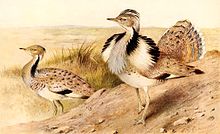- MacQueen's Bustard
-
MacQueen's Bustard 
Scientific classification Kingdom: Animalia Phylum: Chordata Class: Aves Order: Gruiformes Family: Otidae Genus: Chlamydotis Species: C. macqueenii Binomial name Chlamydotis macqueenii
(J E Gray, 1832)The MacQueen's Bustard, Chlamydotis macqueenii, is a large bird in the bustard family. It breeds in southwestern Asia. It has recently been split as a separate species from the Houbara Bustard, Chlamydotis undulata of the Canary Islands and north Africa. These two species are the only members of the Chlamydotis genus.
The dividing line between the two species is the Sinai peninsula. MacQueen's has a greater tendency to wander than the sedentary Houbara Bustard and a handful of Chlamydotis bustards have reached Great Britain, mainly in the 19th century. All those attributable to a species have been the more geographically remote Macqueen's.
It is unlikely that any more of this species will reach western Europe, since it has been hunted to near-extinction in the Middle East by Arab falconers. Conservation efforts by the late Shaikh Zayed bin Sultan Al Nahyan in the United Arab Emirates have given some hope for the future of this Bustard. [1]
This species breeds in deserts and other very arid sandy areas. It is 60 cm long with an 140 cm wingspan. It is brown above and white below, with a black stripe down the sides of its neck. In flight, the long wings show large areas of black and brown on the flight feathers. Sexes are similar, but the female is smaller and greyer above. Macqueen’s Bustard is vocally almost silent. Macqueen's is slightly larger and paler than Houbara.
Like other bustards, these have a flamboyant display raising the white feathers of the head and throat and withdrawing the head. 2-4 eggs are laid on the ground.
This species is omnivorous taking seeds, insects and other small creatures. It is named after the British soldier and collector General Thomas MacQueen.
External links
- Taxonomic recommendations for British birds (PDF format).
Categories:- Otididae
- Birds of Pakistan
- Birds of Turkey
Wikimedia Foundation. 2010.
